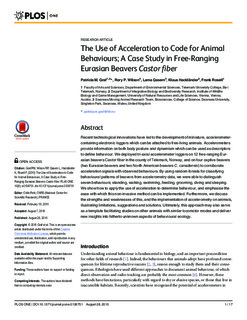The Use of Acceleration to Code for Animal Behaviours; A Case Study in Free-Ranging Eurasian Beavers Castor fiber
Journal article, Peer reviewed
Published version

View/
Date
2015-08-28Metadata
Show full item recordCollections
Original version
Graf, P.M., Wilson, R.P., Qasem, L., Hackländer, K. & Rosell, F. The Use of Acceleration to Code for Animal Behaviours; A Case Study in Free-Ranging Eurasian Beavers Castor fiber. PLoS ONE 10(8): e0136751 http://dx.doi.org/10.1371/journal.pone.0136751Abstract
Recent technological innovations have led to the development of miniature, accelerometercontaining electronic loggers which can be attached to free-living animals. Accelerometers provide information on both body posture and dynamism which can be used as descriptors to define behaviour. We deployed tri-axial accelerometer loggers on 12 free-ranging Eurasian beavers Castor fiber in the county of Telemark, Norway, and on four captive beavers (two Eurasian beavers and two North American beavers C. canadensis) to corroborate acceleration signals with observed behaviours. By using random forests for classifying behavioural patterns of beavers from accelerometry data, we were able to distinguish seven behaviours; standing, walking, swimming, feeding, grooming, diving and sleeping. We show how to apply the use of acceleration to determine behaviour, and emphasise the ease with which this non-invasive method can be implemented. Furthermore, we discuss the strengths and weaknesses of this, and the implementation of accelerometry on animals, illustrating limitations, suggestions and solutions. Ultimately, this approach may also serve as a template facilitating studies on other animals with similar locomotor modes and deliver new insights into hitherto unknown aspects of behavioural ecology
